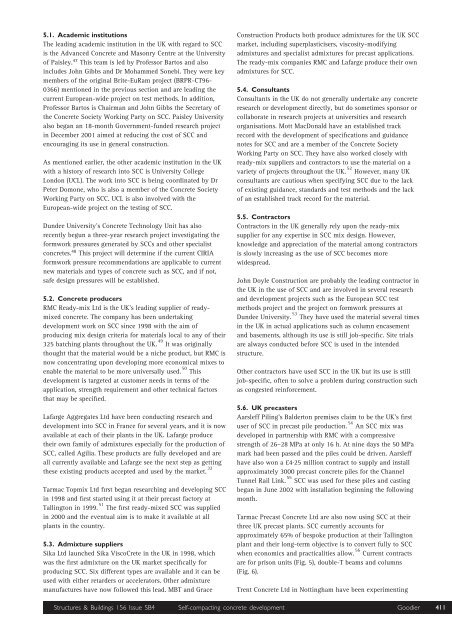Development of self-compacting concrete
Development of self-compacting concrete
Development of self-compacting concrete
You also want an ePaper? Increase the reach of your titles
YUMPU automatically turns print PDFs into web optimized ePapers that Google loves.
5.1. Academic institutions<br />
The leading academic institution in the UK with regard to SCC<br />
is the Advanced Concrete and Masonry Centre at the University<br />
<strong>of</strong> Paisley. 47 This team is led by Pr<strong>of</strong>essor Bartos and also<br />
includes John Gibbs and Dr Mohammed Sonebi. They were key<br />
members <strong>of</strong> the original Brite-EuRam project (BRPR-CT96-<br />
0366) mentioned in the previous section and are leading the<br />
current European-wide project on test methods. In addition,<br />
Pr<strong>of</strong>essor Bartos is Chairman and John Gibbs the Secretary <strong>of</strong><br />
the Concrete Society Working Party on SCC. Paisley University<br />
also began an 18-month Government-funded research project<br />
in December 2001 aimed at reducing the cost <strong>of</strong> SCC and<br />
encouraging its use in general construction.<br />
As mentioned earlier, the other academic institution in the UK<br />
with a history <strong>of</strong> research into SCC is University College<br />
London (UCL). The work into SCC is being coordinated by Dr<br />
Peter Domone, who is also a member <strong>of</strong> the Concrete Society<br />
Working Party on SCC. UCL is also involved with the<br />
European-wide project on the testing <strong>of</strong> SCC.<br />
Dundee University’s Concrete Technology Unit has also<br />
recently begun a three-year research project investigating the<br />
formwork pressures generated by SCCs and other specialist<br />
<strong>concrete</strong>s. 48 This project will determine if the current CIRIA<br />
formwork pressure recommendations are applicable to current<br />
new materials and types <strong>of</strong> <strong>concrete</strong> such as SCC, and if not,<br />
safe design pressures will be established.<br />
5.2. Concrete producers<br />
RMC Ready-mix Ltd is the UK’s leading supplier <strong>of</strong> readymixed<br />
<strong>concrete</strong>. The company has been undertaking<br />
development work on SCC since 1998 with the aim <strong>of</strong><br />
producing mix design criteria for materials local to any <strong>of</strong> their<br />
325 batching plants throughout the UK. 49 It was originally<br />
thought that the material would be a niche product, but RMC is<br />
now concentrating upon developing more economical mixes to<br />
enable the material to be more universally used. 50 This<br />
development is targeted at customer needs in terms <strong>of</strong> the<br />
application, strength requirement and other technical factors<br />
that may be specified.<br />
Lafarge Aggregates Ltd have been conducting research and<br />
development into SCC in France for several years, and it is now<br />
available at each <strong>of</strong> their plants in the UK. Lafarge produce<br />
their own family <strong>of</strong> admixtures especially for the production <strong>of</strong><br />
SCC, called Agilia. These products are fully developed and are<br />
all currently available and Lafarge see the next step as getting<br />
these existing products accepted and used by the market. 32<br />
Tarmac Topmix Ltd first began researching and developing SCC<br />
in 1998 and first started using it at their precast factory at<br />
Tallington in 1999. 51 The first ready-mixed SCC was supplied<br />
in 2000 and the eventual aim is to make it available at all<br />
plants in the country.<br />
5.3. Admixture suppliers<br />
Sika Ltd launched Sika ViscoCrete in the UK in 1998, which<br />
was the first admixture on the UK market specifically for<br />
producing SCC. Six different types are available and it can be<br />
used with either retarders or accelerators. Other admixture<br />
manufactures have now followed this lead. MBT and Grace<br />
Construction Products both produce admixtures for the UK SCC<br />
market, including superplasticisers, viscosity-modifying<br />
admixtures and specialist admixtures for precast applications.<br />
The ready-mix companies RMC and Lafarge produce their own<br />
admixtures for SCC.<br />
5.4. Consultants<br />
Consultants in the UK do not generally undertake any <strong>concrete</strong><br />
research or development directly, but do sometimes sponsor or<br />
collaborate in research projects at universities and research<br />
organisations. Mott MacDonald have an established track<br />
record with the development <strong>of</strong> specifications and guidance<br />
notes for SCC and are a member <strong>of</strong> the Concrete Society<br />
Working Party on SCC. They have also worked closely with<br />
ready-mix suppliers and contractors to use the material on a<br />
variety <strong>of</strong> projects throughout the UK. 52 However, many UK<br />
consultants are cautious when specifying SCC due to the lack<br />
<strong>of</strong> existing guidance, standards and test methods and the lack<br />
<strong>of</strong> an established track record for the material.<br />
5.5. Contractors<br />
Contractors in the UK generally rely upon the ready-mix<br />
supplier for any expertise in SCC mix design. However,<br />
knowledge and appreciation <strong>of</strong> the material among contractors<br />
is slowly increasing as the use <strong>of</strong> SCC becomes more<br />
widespread.<br />
John Doyle Construction are probably the leading contractor in<br />
the UK in the use <strong>of</strong> SCC and are involved in several research<br />
and development projects such as the European SCC test<br />
methods project and the project on formwork pressures at<br />
Dundee University. 53 They have used the material several times<br />
in the UK in actual applications such as column encasement<br />
and basements, although its use is still job-specific. Site trials<br />
are always conducted before SCC is used in the intended<br />
structure.<br />
Other contractors have used SCC in the UK but its use is still<br />
job-specific, <strong>of</strong>ten to solve a problem during construction such<br />
as congested reinforcement.<br />
5.6. UK precasters<br />
Aarsleff Piling’s Balderton premises claim to be the UK’s first<br />
user <strong>of</strong> SCC in precast pile production. 54 An SCC mix was<br />
developed in partnership with RMC with a compressive<br />
strength <strong>of</strong> 26–28 MPa at only 16 h. At nine days the 50 MPa<br />
mark had been passed and the piles could be driven. Aarsleff<br />
have also won a £4·25 million contract to supply and install<br />
approximately 3000 precast <strong>concrete</strong> piles for the Channel<br />
Tunnel Rail Link. 55 SCC was used for these piles and casting<br />
began in June 2002 with installation beginning the following<br />
month.<br />
Tarmac Precast Concrete Ltd are also now using SCC at their<br />
three UK precast plants. SCC currently accounts for<br />
approximately 65% <strong>of</strong> bespoke production at their Tallington<br />
plant and their long-term objective is to convert fully to SCC<br />
when economics and practicalities allow. 56 Current contracts<br />
are for prison units (Fig. 5), double-T beams and columns<br />
(Fig. 6).<br />
Trent Concrete Ltd in Nottingham have been experimenting<br />
Structures & Buildings 156 Issue SB4 Self-<strong>compacting</strong> <strong>concrete</strong> development<br />
Goodier 411
















